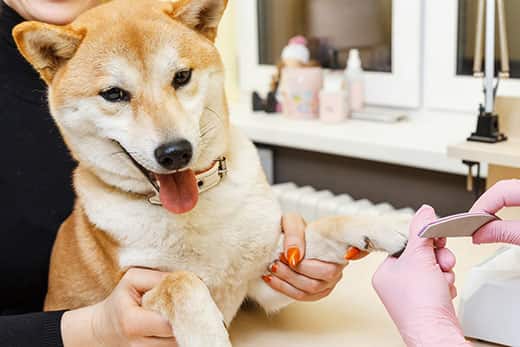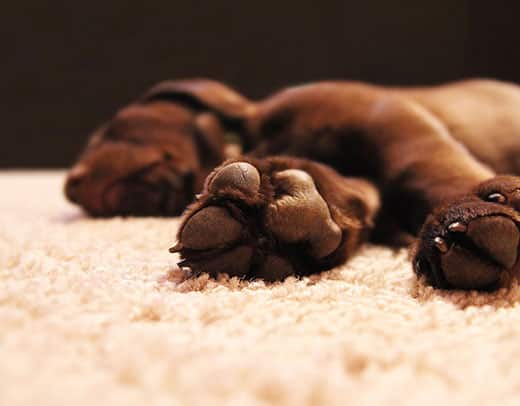
How to trim a dog’s nails, or dog manicure
The question of how to properly trim a dog’s nails is of interest to many caring pet owners. Regardless of whether you have a pet for the first time or have been concerned about this issue for a long time, it is important to learn how to give a dog a pedicure correctly.
Contents
Benefits of trimmed nails
Before you try to trim your dog’s nails, think about why you’re doing it. Unlike human pedicures, which involve trimming and polishing the nails, as well as treating the feet with a light massage, pedicures for dogs are done simply to shorten the claws. Overgrown nails are the catalyst for many health problems. “With every step a dog takes, the long claw touches the ground, causing a return of force to the tendons, which creates uncomfortable pressure while walking,” says the American Kennel Club. Over time, this can lead to orthopedic problems affecting not only the dog’s foot, but also its weight distribution, which in turn will have a negative effect on many other joints and muscles in the body.
Long claws can also break off, causing pain to the pet. In addition, the problem of exfoliating claws cannot always be eliminated by simply cutting them. When they are trimmed, they can delaminate even more, and then you may not be able to do without the help of a veterinarian. Finally, in the most severe cases, too long claws can grow into the pad. This often happens with older or neglected dogs who are already sore from long nails that cause them to avoid walking on hard surfaces.

Tools needed for a dog pedicure
It’s actually pretty easy to trim your dog’s nails at home if you use the right tools. The best part is that you need very little to be successful: a nail cutter, hemostatic powder, treats, and maybe one helper. Oh, and don’t forget to invite your dog to this event.
1. Kogterez
The first and possibly the most important tool you will need to trim your dog’s nails is a nail clipper. The shops will offer you several varieties, including guillotine nail clippers, nail clippers, and scissors. Don’t let these names scare you. Ask your groomer or veterinarian about which tool they recommend for your dog. Guillotine nail cutters are more suitable for small dogs, and secateurs and scissors are more suitable for large ones. However, the tool that works best for you will work best. Don’t worry about how to trim a dog’s nails with a nail clipper – it will be easier to do this with a little treat and praise for the pet.
Another possible option are scratching posts. They will come in handy if you prefer to file a claw, rather than trim it. A scratching post can only remove a small part of the claw. It may be safer than a nail cutter because it avoids damaging the pulp, the delicate blood vessels inside the nail. However, the scratching post often makes noise, causing some dogs to become anxious or afraid of this tool. In addition, shortening the nails with a scratching post will take much longer, so the pet will have to be patient.
2. Hemostatic powder
If you cut off too much, the claw can start to bleed, resulting in a mess and a stressful situation for both you and your pet. A styptic powder or other blood clotting agent recommended by your veterinarian will stop the bleeding as soon as possible. Keep in mind that clotting powder can only be used if your pet’s claw is bleeding from cutting too deep.
3. Treats
Praise for good behavior will make the grooming process enjoyable for both you and your pet. Treats are especially helpful for puppies and anxious dogs who are new to nail clipping. Most importantly, don’t forget to choose healthy treats for your dogs, as well as praise them in an uplifting and contented tone.
4. Assistant
While a helper is not required, it may be worth calling a friend or relative to help hold the dog while you trim its nails. Likewise, if you’re overly anxious or have had problems trimming your nails in the past, it’s still best to leave it to the groomer or veterinarian. In this case, be sure to sign up for procedures regularly so that the dog does not experience discomfort in between.
However, if you feel that you are ready to trim your dog’s claws at home, then feel free to do it.

How to trim your dog’s nails
Trimming your dog’s nails is actually pretty easy. Just lift the dog’s paw and, holding it firmly with your hand, turn it so that you can attach the nail cutter or scratching post to the overgrown area of the claw. Then carefully start cutting. Cut off tiny sections until you feel you have cut enough. Be careful not to damage the pulp. If the dog has white nails, you can see a pinkish shadow of the pulp when you look from the side. With a black claw, it’s a little more complicated. If you see a small black dot looking directly at the incision, you can stop. Most likely, you have already reached the pulp.
However, if you are afraid to cut your dog’s nails, relying only on these instructions, you can take the dog to the groomer or veterinary specialist, who will explain everything in more detail. They will show the application of these techniques in practice, and next time you can easily carry out the procedure yourself.
“Don’t forget about the dewclaw too. Since this toe is located just above the foot, unlike other claws, it does not touch the ground when walking,” advise the staff of the Washington State University College of Veterinary Medicine. In fact, injuries to dewclaws are very common, and trimming the nails on such fingers helps to avoid many problems. Trim them exactly as you would other nails, but keep a close eye on them as they may need to be trimmed more often.
Now that you know how to trim your dog’s nails, you might be wondering how long (or short!) they should stay after trimming. It is impossible to give an exact length of claws because dogs come in a wide variety of shapes and sizes, but the gold standard is the length at which the dog’s claws do not touch the floor when walking. If you hear your dog’s claws clicking on the floor, it’s probably time to trim them.





